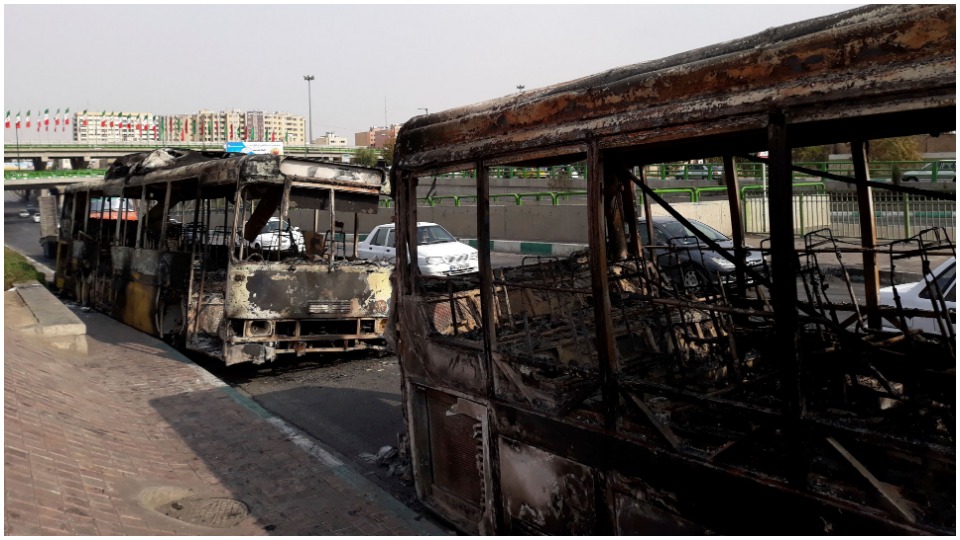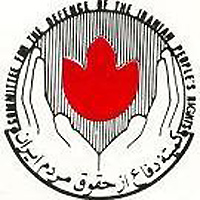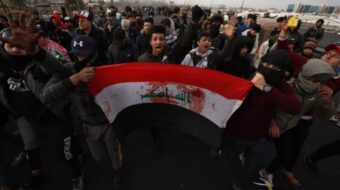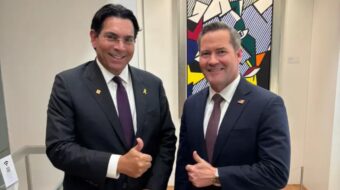
The recent order by Iranian “Supreme Leader” Ali Khamenei directing the security forces “to implement their tasks” sent out a stark and ominous signal to the people of Iran.
Protests erupted in cities across Iran on Friday following the government’s announcement of a hike in the cost of gasoline by at least 50%, signaling further hardship for the Iranian people at a time when the economy is already under intense pressure.
Khamenei’s warning to Iran’s citizens, to stay away from the demonstrations, indicated that a violent crackdown was looming. Economic protests in late 2017 into 2018 that rocked cities across the country were met with a heavy response by the police and the paramilitary Basij force. A similar situation is now unfolding, with reports suggesting over 100 and as many as 200 people have been killed.
“Such illegal actions would not solve any problem but add insecurity on top of other problems,” Khamenei said, referring to protests. “Lack of security is the biggest calamity for any country and society. That is what they are looking for.”
The semi-official ISNA news agency reported that Iran’s Supreme National Security Council ordered a nationwide “restriction of access” to the internet in order to suppress the spread of information about the protests as well as any attempts to coordinate and organize them by activists.
The disruption to internet access—not an unusual feature of life in Iran by any means—is described as the most severe recorded in Iran since Hassan Rouhani came to power, and the most severe disconnection tracked in any country in terms of its breadth and technical complexity.
Demonstrations quickly amassed large numbers and turned violent in several instances, particularly following the deployment of riot police and paramilitaries, with online videos showing tear gas being fired directly at protesters—chillingly reminiscent of the tactics adopted by the security forces in Iraq in recent weeks during the protests there.
Indeed, it is widely alleged that the Islamic Revolutionary Guard Corps and its associated militias have had a prominent role in the lethal security response to those protests.
The gas price hike is seen as a major political risk for Rouhani with parliamentary elections approaching in February. The protests are the latest display of widespread anger among Iran’s population of 80 million who have seen their savings evaporate, unemployment skyrocket, and the collapse to near worthlessness of the national currency, the rial.
Further coverage of Iran:
How did the Iranian Revolution go so far off the rails?
As it happened: The promise—and betrayal—of Iran’s 1979 revolution
Trump ordered strikes on Iran but backed away in last minute
Opposition forces inside Iran have pointed out that the impact of the price increase is not just about the price of gas at the pump but the impact upon the price of food products, public transport fares, and all daily necessities for families.
The increase in the price of gas particularly hits those already beleaguered by low pay in state sector jobs like teachers, who often rely on their car to supplement their income by moonlighting as unlicensed taxi drivers.
On Saturday, the start of the Iranian working week, protesters in Tehran stopped their cars on major roadways across the city, including the Imam Ali Highway, where they called for police to join them. This was part of a mass pattern where the cars would then be locked and left in the middle of road, bringing paralysis to transport across the capital.
Protests require prior approval from Iran’s Interior Ministry, though authorities have allowed small-scale demonstrations over economic issues, especially as the country has struggled with currency devaluation. However, protests directly and explicitly against the government, such as those that have taken place over the last three days, are systematically prohibited and meet a typically brutal response if they then go ahead.
While the authorities are keen to blame any disorder and violence on so-called “hooligans” and “thugs,” it is clear that the protests are widespread and engaging large sections of the population, with significant participation drawn from the country’s youth. Thousands have already been detained for their participation in the protest demonstrations.
A large crowd in the city of Kermanshah in the west of the country demonstrated and later drew tear gas fire from the police. Significant clashes also occurred in Tabriz, another major Iranian city. The protests turned first turned deadly in the southern city of Behbahan when regime security forces tore into the demonstrators, killing four of them. The violent response of security forces has now spread.
Widely circulated footage appeared to show several instances of live rounds being fired, seemingly without restraint, at demonstrators in the streets.
While the announcement of the rise in the price of gas which sparked the protests was made suddenly, it is reported that plans had been made for the increase earlier in the year but had been delayed owing to the government’s fear of the likely backlash from the people.
The price increase comes on the back of the wholesale mismanagement of the Iranian economy by the regime, with domestic industries and manufacturing decimated and a large and growing section of the Iranian population pushed into absolute poverty.

The is situation exacerbated by rampant government corruption and the crippling sanctions, ratcheted up by the U.S. following its unilateral withdrawal from the 2015 Joint Comprehensive Plan of Action (JCPOA) nuclear deal.
These protests and the reaction to them lay bare the fragility of the Iranian regime and its default recourse to brutal violence as the first line of defense when faced with protests on the streets.
The people of Iran will continue to press their demands for peace, human rights, and social justice. And all those for peace and progress from around the world must continue to show their solidarity and ensure that they are supported.
Meanwhile, the Iranian government has pledged to continue with the current measures including its rollout of subsidies financed from the gas price rise and—along with the continuing internet outage—it was announced that schools, universities, and administrative buildings in several areas will remain closed with many localities in a state of near lockdown, in a bid to prevent the protests from continuing.










